Abstract
Catecholamine-induced lipolysis in isolated human adipocytes during the first year of life was investigated. During this period fat cell size increased markedly. Basal and catecholamine-induced glycerol release were positively correlated with age when lipolysis was expressed per cell. However, when lipolysis was expressed per unit of cell surface area (micrometer squared), this correlation was observed only for noradrenaline. Basal lipolysis and the effect of the pure beta-agonist, isoprenaline, were identical in infants and adults. From 0 to 2 mo of age noradrenaline had very little lipolytic effect. The addition of the alpha-2-adrenoceptor antagonist, yohimbine, to noradrenaline equalized lipolysis per micrometer squared in infants and adults and the alpha-2-adrenoceptor sensitivity was significantly enhanced in infants. In both groups the lipolytic adrenoceptor was of the beta-1 type. In conclusion, adipocytes from infants have a poor lipolytic response to noradrenaline partly because of the small fat cells but mainly because of an enhanced alpha-2-adrenoceptor activity.
Full text
PDF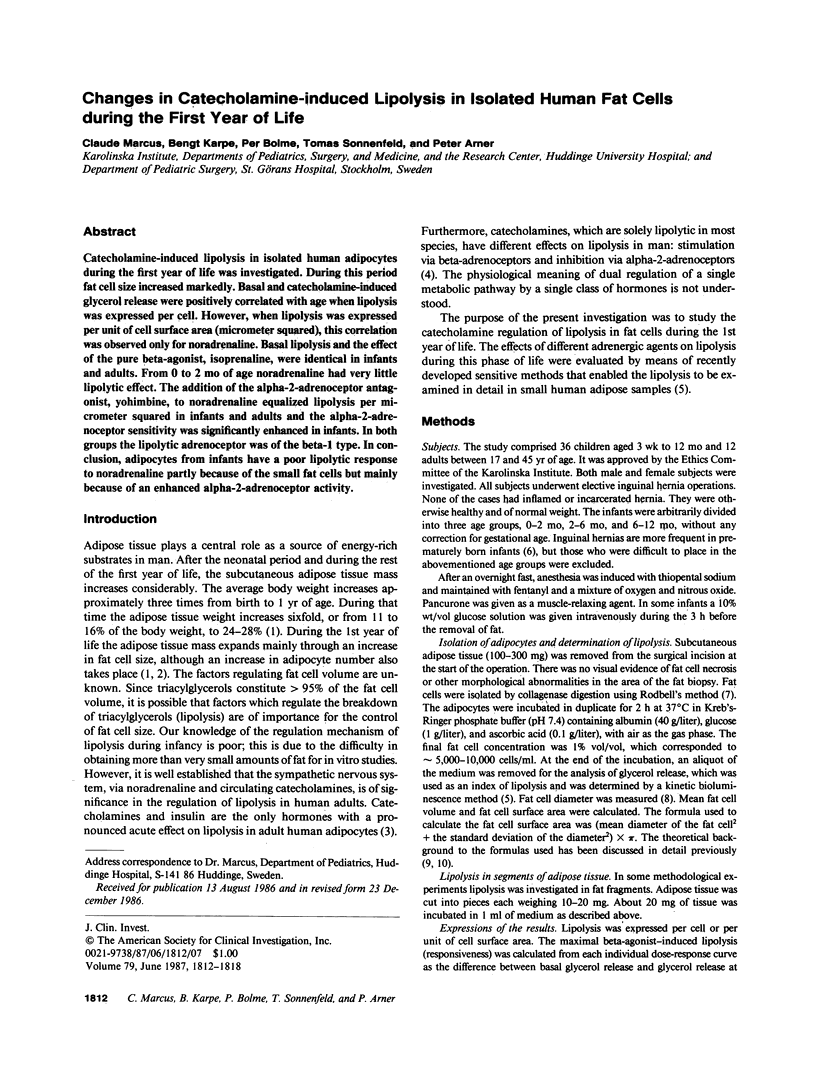
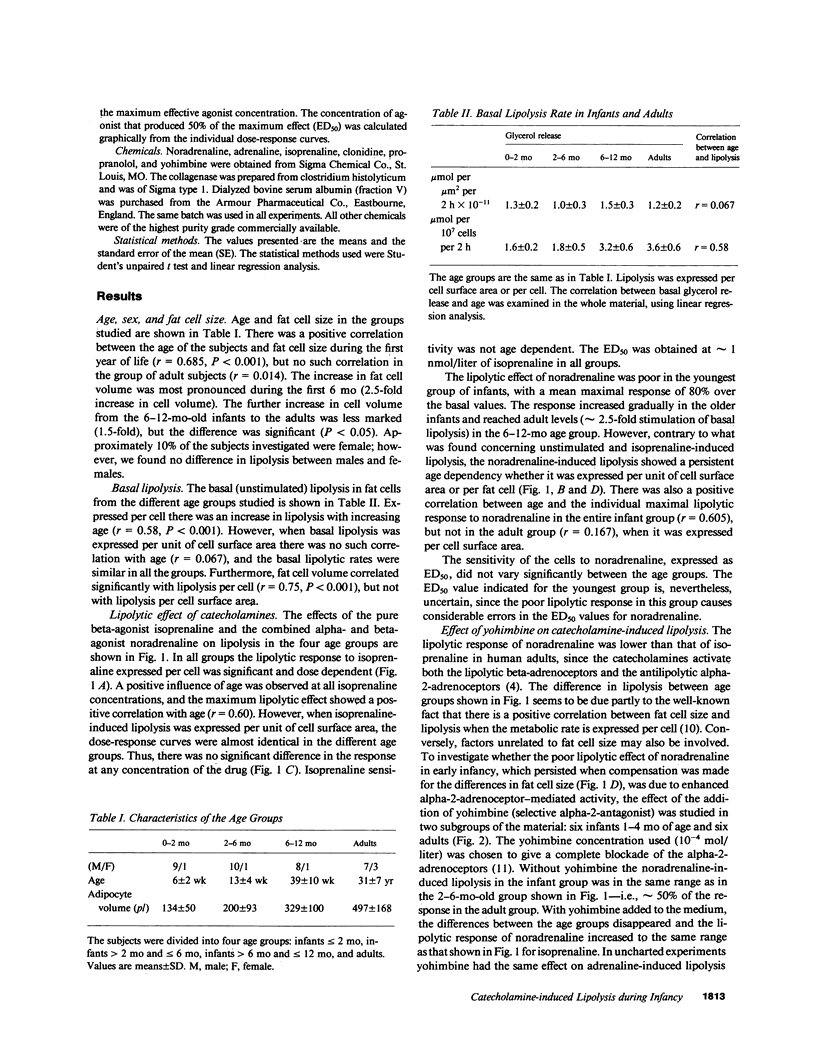
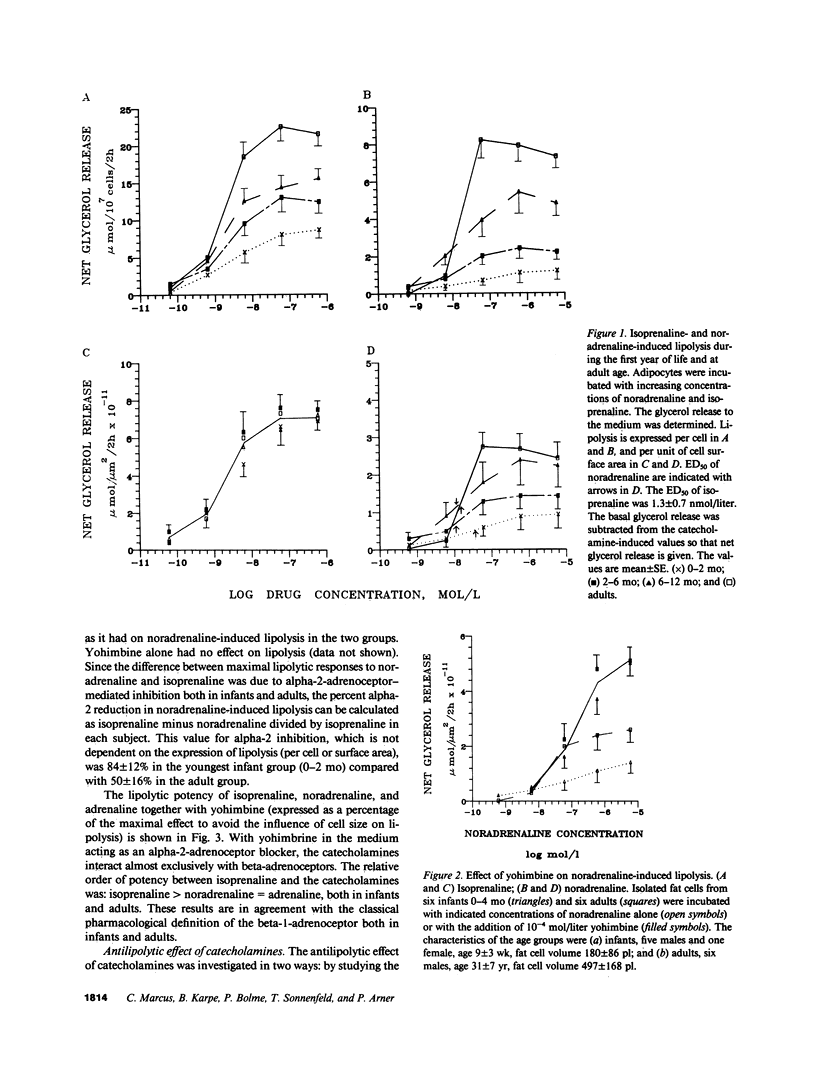
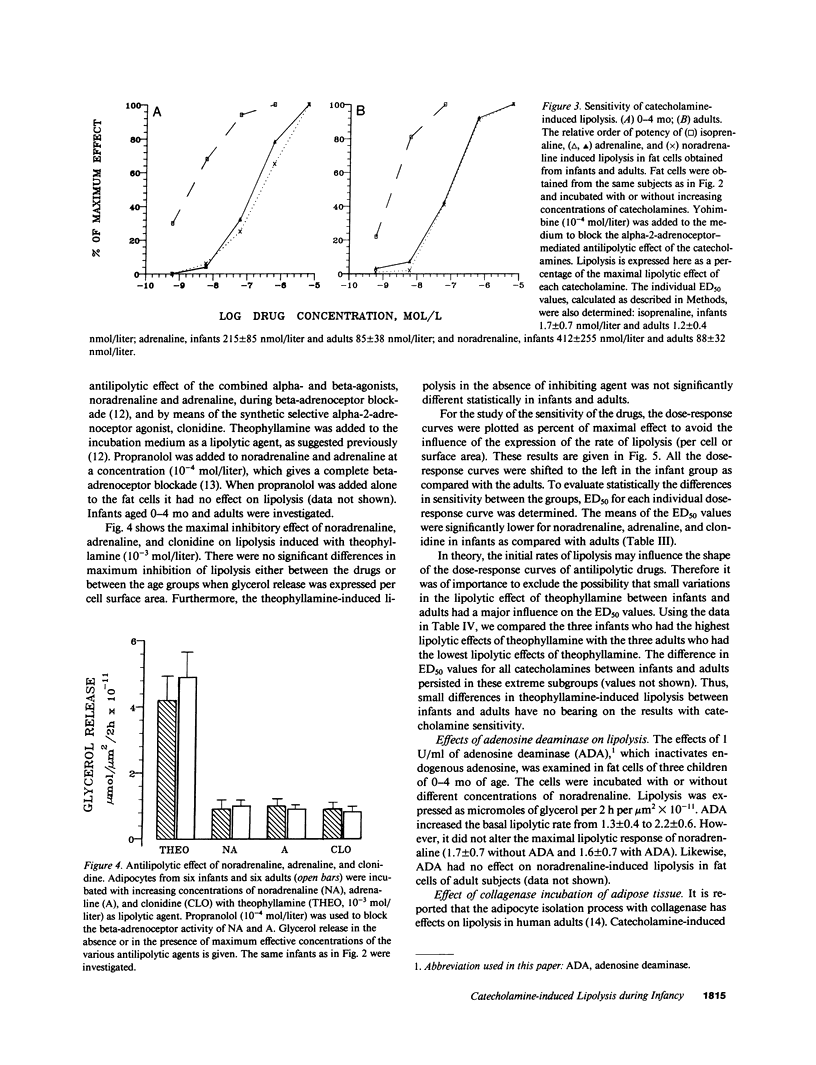
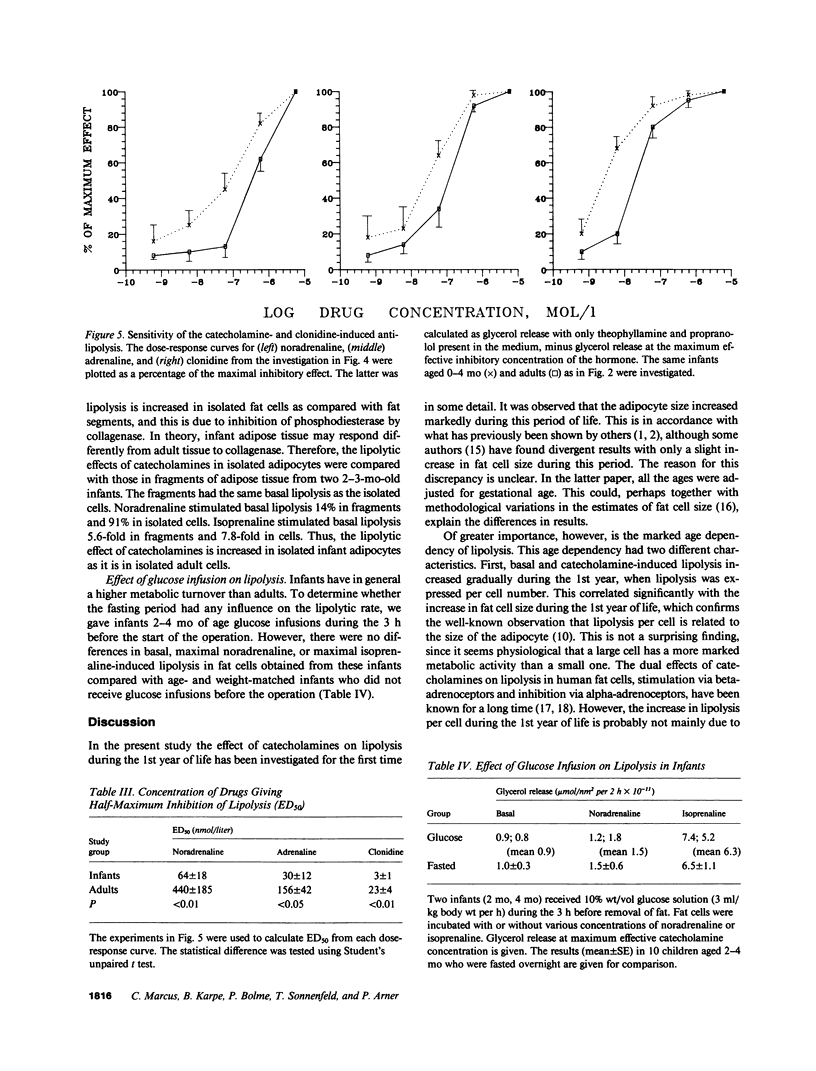
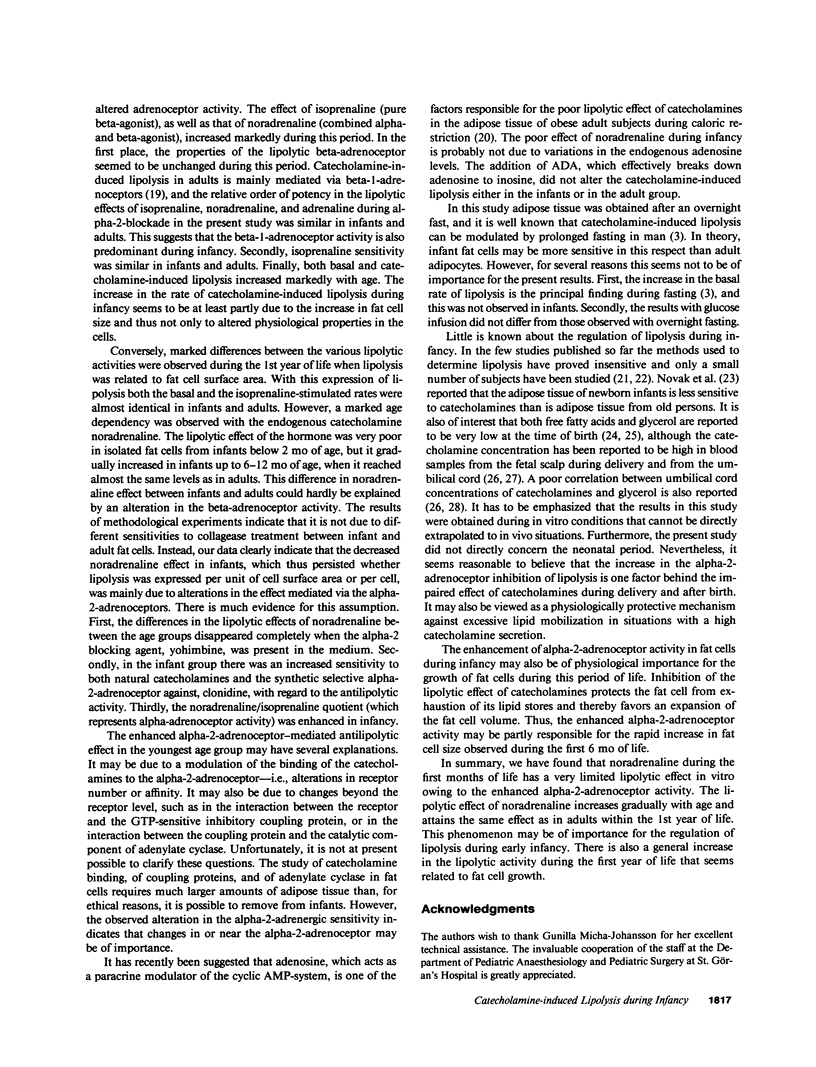
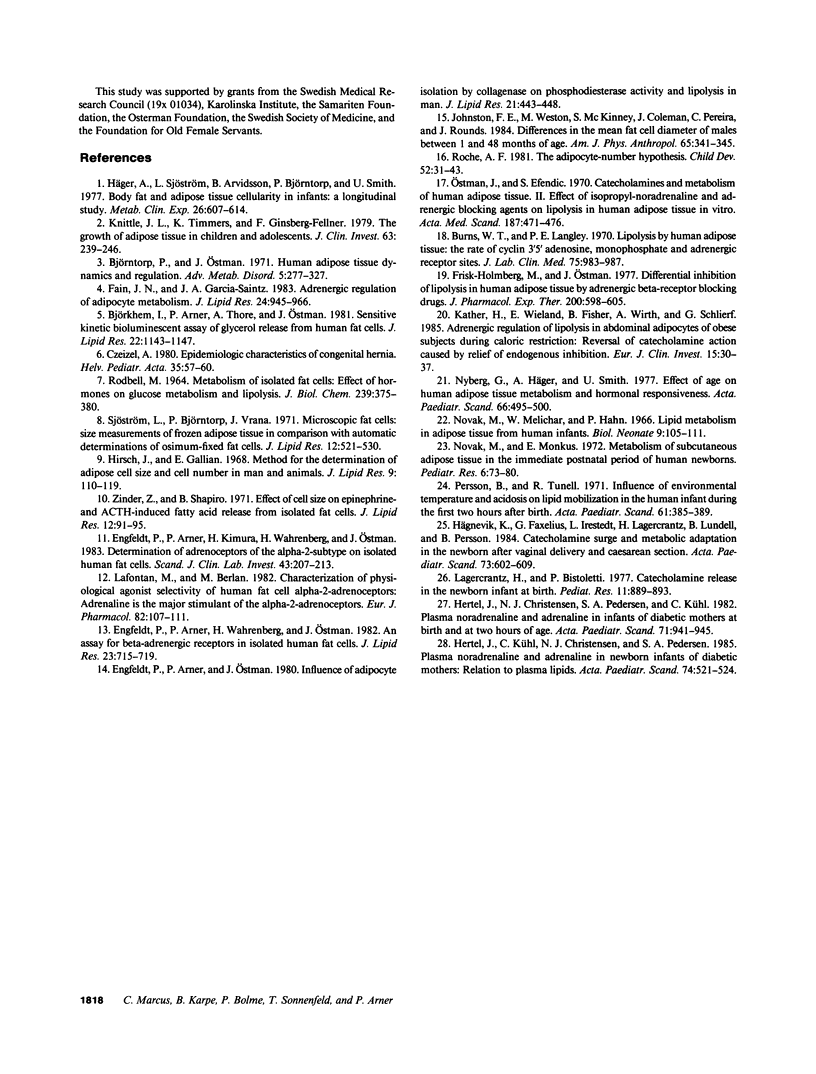
Selected References
These references are in PubMed. This may not be the complete list of references from this article.
- Björkhem I., Arner P., Thore A., Ostman J. Sensitive kinetic bioluminescent assay of glycerol release from human fat cells. J Lipid Res. 1981 Sep;22(7):1142–1147. [PubMed] [Google Scholar]
- Björntorp P., Ostman J. Human adipose tissue dynamics and regulation. Adv Metab Disord. 1971;5:277–327. doi: 10.1016/b978-0-12-027305-8.50027-8. [DOI] [PubMed] [Google Scholar]
- Burns T. W., Langley P. E. Lipolysis by human adipose tissue: the role of cyclic 3',5'-adenosine monophosphate and adrenergic receptor sites. J Lab Clin Med. 1970 Jun;75(6):983–997. [PubMed] [Google Scholar]
- Czeizel A. Epidemiologic characteristics of congenital inguinal hernia. Helv Paediatr Acta. 1980 Mar;35(1):57–67. [PubMed] [Google Scholar]
- Engfeldt P., Arner P., Kimura H., Wahrenberg H., Ostman J. Determination of adrenoceptors of the alpha 2-subtype on isolated human fat cells. Scand J Clin Lab Invest. 1983 May;43(3):207–213. doi: 10.1080/00365518309168246. [DOI] [PubMed] [Google Scholar]
- Engfeldt P., Arner P., Ostman J. Influence of adipocyte isolation by collagenase on phosphodiesterase activity and lipolysis in man. J Lipid Res. 1980 May;21(4):443–448. [PubMed] [Google Scholar]
- Engfeldt P., Arner P., Wahrenberg H., Ostman J. An assay for beta-adrenergic receptors in isolated human fat cells. J Lipid Res. 1982 Jul;23(5):715–719. [PubMed] [Google Scholar]
- Fain J. N., Garcĩa-Sáinz J. A. Adrenergic regulation of adipocyte metabolism. J Lipid Res. 1983 Aug;24(8):945–966. [PubMed] [Google Scholar]
- Frisk-Holmberg M., Ostman J. Differential inhibition of lipolysis in human adipose tissue by adrenergic beta receptor blocking drugs. J Pharmacol Exp Ther. 1977 Mar;200(3):598–605. [PubMed] [Google Scholar]
- Hertel J., Christensen N. J., Pedersen S. A., Kühl C. Plasma noradrenaline and adrenaline in infants of diabetic mothers at birth and at two hours of age. Acta Paediatr Scand. 1982 Nov;71(6):941–945. doi: 10.1111/j.1651-2227.1982.tb09553.x. [DOI] [PubMed] [Google Scholar]
- Hertel J., Kühl C., Christensen N. J., Pedersen S. A. Plasma noradrenaline and adrenaline in newborn infants of diabetic mothers: relation to plasma lipids. Acta Paediatr Scand. 1985 Jul;74(4):521–524. doi: 10.1111/j.1651-2227.1985.tb11021.x. [DOI] [PubMed] [Google Scholar]
- Hirsch J., Gallian E. Methods for the determination of adipose cell size in man and animals. J Lipid Res. 1968 Jan;9(1):110–119. [PubMed] [Google Scholar]
- Häger A., Sjöstrm L., Arvidsson B., Björntorp P., Smith U. Body fat and adipose tissue cellularity in infants: a longitudinal study. Metabolism. 1977 Jun;26(6):607–614. doi: 10.1016/0026-0495(77)90082-8. [DOI] [PubMed] [Google Scholar]
- Hägnevik K., Faxelius G., Irestedt L., Lagercrantz H., Lundell B., Persson B. Catecholamine surge and metabolic adaptation in the newborn after vaginal delivery and caesarean section. Acta Paediatr Scand. 1984 Sep;73(5):602–609. doi: 10.1111/j.1651-2227.1984.tb09982.x. [DOI] [PubMed] [Google Scholar]
- Johnston F. E., Weston M., McKinney S., Coleman J., Pereira G., Rounds J. Differences in the mean fat cell diameter of males between 1 and 48 months of age. Am J Phys Anthropol. 1984 Dec;65(4):341–345. doi: 10.1002/ajpa.1330650402. [DOI] [PubMed] [Google Scholar]
- Kather H., Wieland E., Fischer B., Wirth A., Schlierf G. Adrenergic regulation of lipolysis in abdominal adipocytes of obese subjects during caloric restriction: reversal of catecholamine action caused by relief of endogenous inhibition. Eur J Clin Invest. 1985 Feb;15(1):30–37. doi: 10.1111/j.1365-2362.1985.tb00140.x. [DOI] [PubMed] [Google Scholar]
- Knittle J. L., Timmers K., Ginsberg-Fellner F., Brown R. E., Katz D. P. The growth of adipose tissue in children and adolescents. Cross-sectional and longitudinal studies of adipose cell number and size. J Clin Invest. 1979 Feb;63(2):239–246. doi: 10.1172/JCI109295. [DOI] [PMC free article] [PubMed] [Google Scholar]
- Lafontan M., Berlan M. Characterization of physiological agonist selectivity of human fat cell alpha 2-adrenoceptors: adrenaline is the major stimulant of the alpha 2-adrenoceptors. Eur J Pharmacol. 1982 Aug 13;82(1-2):107–111. doi: 10.1016/0014-2999(82)90562-3. [DOI] [PubMed] [Google Scholar]
- Lagercrantz H., Bistoletti P. Catecholamine release in the newborn infant at birth. Pediatr Res. 1977 Aug;11(8):889–893. doi: 10.1203/00006450-197708000-00007. [DOI] [PubMed] [Google Scholar]
- Novak M., Monkus E. Metabolism of subcutaneous adipose tissue in the immediate postnatal period of human newborns. 1. Developmental changes in lipolysis and glycogen content. Pediatr Res. 1972 Feb;6(2):73–80. doi: 10.1203/00006450-197202000-00001. [DOI] [PubMed] [Google Scholar]
- Novák M., Melichar V., Hahn P. Lipid metabolism in adipose tissue from human infants. Biol Neonat. 1965;9(1):105–114. doi: 10.1159/000239982. [DOI] [PubMed] [Google Scholar]
- Nyberg G., Häger A., Smith U. Effect of age on human adipose tissue metabolism and hormonal responsiveness. Acta Paediatr Scand. 1977 Jul;66(4):495–500. doi: 10.1111/j.1651-2227.1977.tb07933.x. [DOI] [PubMed] [Google Scholar]
- Ostman J., Efendić S. Catecholamines and metabolism of human adipose tissue. II. Effect of isoprophylnoradrenaline and adrenergic blocking agents on lipolysis in human omental adipose tissue in vitro. Acta Med Scand. 1970 Jun;187(6):471–476. [PubMed] [Google Scholar]
- Persson B., Tunell R. Influence of environmental temperature and acidosis on lipid mobilization in the human infant during the first two hours after birth. Acta Paediatr Scand. 1971 Jul;60(4):385–398. doi: 10.1111/j.1651-2227.1971.tb06677.x. [DOI] [PubMed] [Google Scholar]
- RODBELL M. METABOLISM OF ISOLATED FAT CELLS. I. EFFECTS OF HORMONES ON GLUCOSE METABOLISM AND LIPOLYSIS. J Biol Chem. 1964 Feb;239:375–380. [PubMed] [Google Scholar]
- Roche A. F. The adipocyte-number hypothesis. Child Dev. 1981 Mar;52(1):31–43. [PubMed] [Google Scholar]
- Sjöström L., Björntorp P., Vrána J. Microscopic fat cell size measurements on frozen-cut adipose tissue in comparison with automatic determinations of osmium-fixed fat cells. J Lipid Res. 1971 Sep;12(5):521–530. [PubMed] [Google Scholar]
- Zinder O., Shapiro B. Effect of cell size on epinephrine- and ACTH-induced fatty acid release from isolated fat cells. J Lipid Res. 1971 Jan;12(1):91–95. [PubMed] [Google Scholar]


